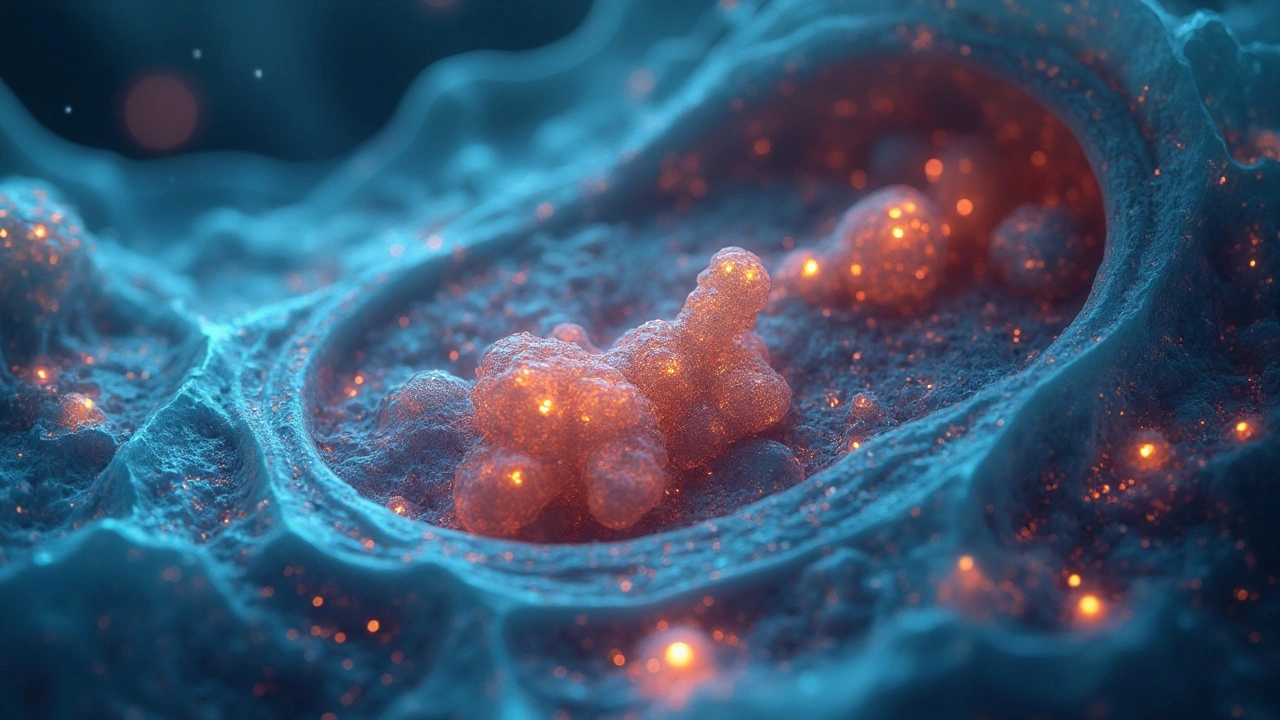Enzyme Deficiency Disorders: Types, Symptoms, And Practical Tips
 Jun, 25 2025
Jun, 25 2025
You wouldn’t believe how fast your body would hit a brick wall without enzymes. These little proteins are backstage heroes, driving everything you do: Eating cake, healing a cut, even growing a single hair depends on them. So, when something’s off with just one type of enzyme, entire systems can go haywire. For thousands of families, enzyme deficiency isn’t some distant idea. It’s a daily reality, showing up as rare diseases, gut problems, and sometimes life-changing emergencies. Picture trying to digest even a basic lunch—or fight an infection—when your body is missing the critical spark that makes the whole process happen.
What Are Enzyme Deficiency Disorders?
Enzymes look unassuming—a few hundred atoms twisted into a shape so specific that if it’s nudged the tiniest bit, it stops working. Every cell in your body houses thousands of types, each designed to speed up (or catalyze) one single reaction. Sometimes, though, there’s a glitch in your DNA—a missing or swapped-out instruction—that leaves you with a defective enzyme, or none at all. That’s an enzyme deficiency disorder, often inherited, but sometimes triggered by things like chronic illness or malnutrition.
One classic example is lactose intolerance. This crops up when you don’t have enough lactase, the enzyme that chops up lactose sugar in milk. A glass of ice cream turns into stomach cramps and regrettable bathroom trips. Some disorders, like Tay-Sachs disease or Gaucher disease, are much more severe. These are caused by missing lysosomal enzymes that clean up the junk in cells. Without them, waste piles up, causing cells (especially nerve cells) to malfunction or die. There are dozens of these disorders, and doctors group them in different ways, usually by the jobs the missing enzymes were supposed to do: digest sugars, clear up fats, break down amino acids, or support immune defense.
Enzyme deficiency disorders can pop up seemingly anywhere: Newborn screening often checks for them. Some people don’t get diagnosed until adulthood. The effects depend wildly on which enzyme is missing. Some are rare—only found in a handful of families. Others, like the glucose-6-phosphate dehydrogenase (G6PD) deficiency, are widespread worldwide, especially in certain ethnic groups.
Main Types of Enzyme Deficiency Disorders
These conditions fall into a few broad buckets, depending on what the broken enzyme’s job is. Most are grouped as metabolic, but not all. Here are some of the more familiar (and some surprising) examples:
- Digestive enzyme deficiencies: The best-known is lactase (for lactose intolerance). But there are others—think sucrase-isomaltase (for sugar in sweets), or pancreatic enzyme deficiencies (which make it hard to digest fats and starches). Kids with cystic fibrosis often get these.
- Carbohydrate metabolism disorders: Classic galactosemia (where babies can’t break down galactose, a sugar in milk) is deadly if not caught immediately. Another, glycogen storage disease, leaves people unable to use their stored sugar properly.
- Lipid metabolism disorders: These include Gaucher disease and Tay-Sachs, both tied to the body’s recycling of fats in nerve and liver cells.
- Amino acid metabolism disorders: The most famous is phenylketonuria (PKU), found by heel-prick tests in newborns. People with PKU can't handle phenylalanine, so it builds up and damages the brain if not managed with a strict diet.
- Purine and pyrimidine disorders: This group is rare, but disorders like Lesch-Nyhan syndrome can cause severe neurological symptoms. Uric acid problems (like gout) relate to this, too.
- Immune system enzyme deficiencies: Severe combined immunodeficiency (SCID), famously called “bubble boy” disease, is caused by missing immune enzyme activity, leaving children defenseless against infections.
Here’s a handy breakdown of some well-known disorders:
| Disorder | Missing Enzyme | Main Symptoms | Prevalence (per 100,000) |
|---|---|---|---|
| Lactose Intolerance | Lactase | Bloating, cramps, diarrhea | 650 (adults) |
| G6PD Deficiency | G6PD | Anemia, fatigue, jaundice | 50-400 (depending on region) |
| PKU | Phenylalanine hydroxylase | Developmental delay, seizures | 0.2 |
| Tay-Sachs | Hexosaminidase A | Neurodegeneration, vision loss | 0.003 |
Genetic counseling becomes crucial for families with a known risk. If you’re adopting or considering having kids, it’s worth knowing your family’s enzyme deficiency history—especially for rare ones like lysosomal storage diseases.

Symptoms to Watch For: More Than Meets the Eye
Most enzyme deficiencies are sneaky. A baby might look perfectly healthy for months, only to develop strange neurologic symptoms later. Or maybe it’s something as nondescript as an adult who just can’t shed constant stomach problems. The signs change dramatically depending on which enzyme is missing, but there are common threads.
Digestive enzyme deficiencies usually show up as bloating, diarrhea, cramping, or unexpected weight loss. My own daughter, Sorrel, went through a stretch of wild belly aches until we realized her body wasn’t breaking down certain sugars. Popcorn at the fair; pain for the next 36 hours. Sometimes symptoms are subtle: Kids might get labeled as “picky eaters” because their bodies learn to avoid what makes them sick.
Metabolic disorders often kick off with ambiguous problems like poor feeding, vomiting, lethargy, or a failure to gain weight. In severe forms, you see neurological symptoms—loss of muscle tone, delayed development, or seizures. Lysosomal storage diseases are particularly cruel. Symptoms can start with swollen bellies (from enlarged livers and spleens), joint pain, or even trouble seeing and hearing. As toxic molecules build up, nerve cells start fading. PKU and similar amino-acid disorders start mild but can cause intellectual disability if not caught before symptoms begin.
Immune enzyme deficiencies—like SCID—are usually caught through constant, severe infections that just won’t clear up, even with antibiotics. In many places, newborn screening will pick up these before the first symptoms even have a chance to start. You may also see unexplained jaundice, bad breath (due to amino acid build-up), or even odd urine smells with some disorders (maple syrup urine disease is an actual diagnosis!).
Here’s a quick summary of common symptoms, grouped by affected system:
- Digestive: Nausea, bloating, stomach pain, diarrhea, unexplained weight loss, nutrient deficiencies
- Neurological: Developmental delay, muscle weakness, seizures, behavioral changes, lack of coordination
- Immune: Frequent/severe infections, slow wound healing
- Hematologic: Anemia, easy bruising, jaundice
- Other: Enlarged liver/spleen, unusual odors in body fluids, failure to thrive
Any cluster of these, especially in babies or children, deserves a visit to a pediatrician for a full workup. Don’t explain away strange symptoms for too long—so many families only get answers after months (or years) of bouncing between doctors.
Diagnosis and Testing: Pinpointing the Culprit
Even though these disorders stem from a single broken enzyme, finding the exact culprit isn’t always fast. Most enzyme deficiency disorders are genetic and show up early, but others can fly under the radar until stress or illness brings out symptoms. The trick to getting diagnosed is finding patterns: unexplained symptoms that don’t fit with common causes.
Doctors typically start with a really detailed history—medical, family, ethnic background, even whether certain foods trigger trouble. Blood and urine tests can reveal byproducts that pile up when an enzyme isn’t working. For example, high phenylalanine in blood spots from newborn screening suggests PKU. Lactose intolerance is usually picked up with a hydrogen breath test (you drink a sugar solution, then your breath is analyzed for gases made by gut bacteria because your body can’t digest the sugar).
High-tech genetic tests are now much more common. A single saliva or blood sample lets labs read through the most common genes for dozens of enzyme deficiencies at once. This is catching problems faster and with more certainty. Doctors may also use specialized enzymatic assays, where they measure the actual enzyme’s activity level in a blood or tissue sample. If they can’t find the faulty enzyme, sometimes biopsies or advanced imaging are needed, especially with rare or unclear metabolic disorders.
Newborn screening programs are a public health breakthrough. In the US, for example, all newborns are now checked for >30 metabolic and enzyme diseases within the first week of life. This has stopped hundreds of deaths and severe neurologic injuries by catching conditions like PKU or galactosemia before symptoms start.
For those with a known family history, prenatal genetic counseling gives families the chance to learn the odds of passing along a disorder. Carrier screening is highly recommended if you or your partner has ancestry from populations with higher risks—for example, Ashkenazi Jewish families have higher Tay-Sachs and Gaucher disease odds.

Treatment, Management, and Living with Enzyme Disorders
This isn’t a field where doctors hand over a magic fix, but treatment options are way better than even a couple decades ago. The most basic approach: Avoid what the body can’t process. For someone with PKU or galactosemia, this means a very strict diet, avoiding proteins or milk sugars. For lactose intolerance, steer clear of milk (or pop a lactase pill). Some digestive enzyme deficiencies are controlled by taking enzyme supplements before meals—these are a lifesaver for people with cystic fibrosis or chronic pancreatitis.
Enzyme replacement therapy is revolutionizing care for many lysosomal storage diseases. Kids and adults get regular infusions of synthetic enzyme, which helps clear out toxic build-up. Gaucher disease went from being a death sentence to a manageable chronic illness, thanks to this treatment. The price tag can be eye-watering—sometimes hundreds of thousands annually—but insurance and patient-assistance programs can help.
Gene therapy is the future for many enzyme disorders. In 2023, the first gene therapy for adenosine deaminase SCID got FDA approval in the US—it essentially replaces the faulty gene so kids can make the enzyme themselves. Similar research is in progress for Pompe disease, Fabry disease, and more.
Daily living means a lot of vigilance: Watching food labels, managing meds, and handling emergencies fast. Schools need to know about enzyme-deficient kids’ special needs, especially since missed meals or illness can be dangerous. I’ve met parents who plan every grocery trip like a military mission just to keep their kids healthy. Support groups and online forums are goldmines for tips—home-tested recipes, the best brands of lactose-free ice cream, how to prep teachers for life-threatening allergies. Don’t try to go it alone if you’re newly diagnosed—the community is surprisingly welcoming and savvy.
When it comes to infection risk, like with immune enzyme disorders, old-fashioned handwashing and up-to-date vaccinations matter big time. Kids with SCID may need to avoid crowds or have special filters for their homes until treatment starts working.
Finally, keep every member of your medical team in the loop—pediatrician, geneticist, nutritionist, pharmacist, and teachers. The best outcomes happen when families have honest, regular conversations about what’s working and what’s not. Waiting for the perfect solution is tough—but piecing together small wins, like finally finding a kid-friendly snack that’s safe, is all part of the journey.

Agha Nugraha
June 28, 2025 AT 20:11Been living with lactose intolerance since college and honestly, this post nailed it. No more guessing if that cheesy pizza was worth the 3am bathroom run. Lactase pills are my new best friends.
Also, never knew G6PD deficiency was so common in South Asia. My cousin in Delhi got diagnosed after a bad bout of jaundice. Turns out he’d been avoiding fava beans his whole life without knowing why.
Andy Smith
June 30, 2025 AT 17:32This is an exceptionally well-researched and clearly structured overview. The breakdown of enzyme categories-digestive, metabolic, immune-is clinically accurate and pedagogically sound. I particularly appreciate the inclusion of prevalence data; it contextualizes rarity without diminishing lived experience.
Enzyme replacement therapy, while costly, has transformed outcomes for lysosomal storage diseases. Recent trials for Pompe disease show promising long-term neuromuscular stabilization. Also, newborn screening protocols in the U.S. have reduced PKU-related intellectual disability by over 95% since the 1960s.
Rekha Tiwari
June 30, 2025 AT 23:35OMG this hit home 😭 My little one was diagnosed with galactosemia at 2 weeks old. We switched to soy formula and now she’s thriving-just turned 4! I used to stress every time someone offered her a yogurt cup… now I just smile and say, ‘She’s got her own special snacks!’
Also, the maple syrup urine disease smell thing? YES. We had a nurse say it smelled like pancakes at the hospital. We laughed through tears. You’re not alone, fam 💛
Leah Beazy
July 1, 2025 AT 08:09My kid has cystic fibrosis and we take pancreatic enzymes with every meal. It’s wild how something so tiny can change everything.
Before we started, he’d lose weight even if he ate like a horse. Now he’s in the 75th percentile for growth. I didn’t know enzymes could be that powerful. Seriously, if you’re struggling with digestion and no one’s checked this-ask your doctor. It’s not just ‘your stomach is sensitive.’ It could be something fixable.
John Villamayor
July 2, 2025 AT 12:05Jenna Hobbs
July 3, 2025 AT 00:05THIS. THIS IS THE POST I NEEDED WHEN I WAS SCARED OUT OF MY MIND. My daughter was diagnosed with SCID at 6 weeks. We thought she had a cold that wouldn’t go away. Turns out she had zero immune defense.
Gene therapy saved her life. She’s now a bouncing 3-year-old who loves playgrounds and peanut butter sandwiches. I cried for three days when I read about the FDA approval in 2023. We are living proof that science doesn’t give up on us.
To anyone reading this: Don’t let doctors dismiss your gut feeling. If something’s off, push. Hard.
Ophelia Q
July 4, 2025 AT 15:30Just wanted to say thank you for writing this. My sister has PKU and I’ve watched her navigate this since we were kids. She’s now a biochemist and helps design low-phenylalanine formulas. She says the hardest part wasn’t the diet-it was people assuming she was ‘just picky’ or ‘making a fuss.’
She’s brilliant. And she eats the weirdest snacks-like specially made protein bars that taste like chalk but keep her brain safe. I love her so much ❤️
Elliott Jackson
July 4, 2025 AT 17:35Okay but let’s be real-most of these ‘disorders’ are just modern laziness wrapped in medical jargon.
Lactose intolerance? Your ancestors drank milk. You’re just weak. PKU? Just eat less protein. And enzyme replacement therapy? That’s Big Pharma’s goldmine.
My cousin in Iowa doesn’t take supplements and he’s 82. He eats cheese, beans, and whiskey. He’s fine. Maybe the real problem is over-medicalizing normal human variation?
Also, why are we testing newborns for everything? Next thing you know, we’ll be screening for ‘low enthusiasm enzyme deficiency.’
McKayla Carda
July 4, 2025 AT 17:40Christopher Ramsbottom-Isherwood
July 5, 2025 AT 12:30Actually, the whole ‘enzyme deficiency’ framework is flawed. It assumes enzymes are the primary drivers of metabolism, when in reality, epigenetic regulation, gut microbiome diversity, and mitochondrial function play far larger roles.
Fixing one enzyme doesn’t fix the system. You’re treating symptoms, not root causes. We’re missing the forest for the protein.
Stacy Reed
July 6, 2025 AT 11:22Have you ever considered that enzyme deficiencies are the body’s way of telling us we’ve lost touch with ancestral diets? Modern processed foods overload our systems. Maybe we don’t need more enzymes… we need less sugar, less wheat, less industrial everything.
My grandmother never took supplements. She ate sourdough, fermented veggies, and lard. She lived to 98. The problem isn’t our genes-it’s our culture.
Robert Gallagher
July 6, 2025 AT 21:52I’ve been managing G6PD deficiency for 30 years. No one talks about the mental toll. You can’t just say ‘avoid fava beans’-you have to check every medication, every supplement, every food label. It’s exhausting.
And then you get people saying ‘it’s just anemia’ like it’s a cold. It’s not. It’s a daily recalibration of your entire life. I’ve missed birthdays because I got sick from a cough syrup. Don’t minimize it.
But hey-I’m still here. And I’m proud of that. Every day I choose to live well, even when the world forgets I exist.
Howard Lee
July 8, 2025 AT 01:51Thank you for including the genetic counseling advice. My wife and I did carrier screening before trying for kids. We found out we’re both carriers for Tay-Sachs. We didn’t panic-we talked to a genetic counselor, got IVF with PGD, and now we have a healthy 1-year-old.
This isn’t a death sentence. It’s a puzzle. And with the right tools, you can solve it.
Nicole Carpentier
July 9, 2025 AT 21:07Hadrian D'Souza
July 11, 2025 AT 01:54Oh look, another feel-good biochemistry article that makes enzymes sound like magic fairy dust.
Let’s not pretend enzyme replacement therapy is a cure. It’s a Band-Aid on a hemorrhage. You’re paying $700,000 a year to keep a dying child alive for another 12 months. That’s not medicine-that’s financial theater.
And gene therapy? The first patient died from insertional mutagenesis. The second had liver failure. We’re playing god with a 10% success rate and calling it progress.
Meanwhile, the real issue is that we’ve outsourced basic biology to biotech CEOs who charge more than a Tesla for a protein drip.
Enjoy your ‘lifesaving’ infusions while the planet burns.